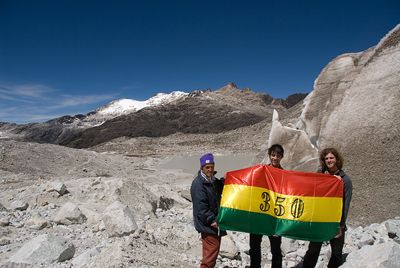The Chacaltaya mountain range contains some of the most symbolic peaks in Bolivia's Andes Mountains. As it once was one of the only places to snow ski in this mountainous country, these mountains are well-known to those in the Department of La Paz, as well as foreign adventurers. The mountains have also hosted charity football matches in which Bolivian President Evo Morales participated, seeking to prove that the sport can be played at high altitudes.
However, Chacaltaya's glacier has been receding at a worrisome and rapid pace. The effects of climate change on this glacier and others in the region have been part of the investigation by Higher University of San Andrés professor Edson Ramírez, who concludes a direct connection [es] between global warming and the disappearance of the glacier.
Ramírez and his team have also been studying another nearby glacier that is undergoing similar changes and about the effect on the local population. The Tuni Condoriri glacier is melting at a rapid pace, affecting alpine enthusiasts, but also affecting a vulnerable migrant population that depends on it for drinking water and agricultural activities.
The reservoir that collects the water from the glacier provides 80% of the drinking water to the city of El Alto and the outskirts of La Paz. According to the most recent census, El Alto has a population of 827,000 people [es], which is increasing every year at a rate of 5.1% per year. According to journalist and blogger Mónica Oblitas, this rate is more than double the national average [es]. Experts are predicting water shortages and a premium for water, with some people predicting that water rationing is imminent [es]. The team from Observador Global [es] (Global Observer) created a 6-part video series about the effects of future water shortages in this region.
The city is home to migrants from the Aymara indigenous communities on the Bolivian Altiplano, who settle in El Alto, often in impoverished conditions. Bolivian blogger Cristina Quisbert of the blog Indigenous Bolivia describes the situation that many residents face in terms of suitable drinking water:
Additional conditions difficult access to water. A lot of people arrive from rural area to El Alto and establish wherever they can. Because of lack of money, they live in neighborhoods where there is neither drinkable water nor sewer system. Some of them dig a hole which should be about three metres deep until they find water. More or less in November, it starts rainy time and it is other possibility for neighbors to collect water. At the end, lack of water added to existent levels of poverty many times result in illnesses.
There is an heterogeneity of situations. I have water at home but some of my neighbors don't. This is a serious problem for the families. In my case, I share water with other family. Basilio and Juana have four children. They are renters. The house where they live doesn't have drinkable water. Whenever they need, they use a hose to collect water from my house and at end of the month we divide the cost of water invoice to pay.
However, the Tuni Condoriri, not only provides drinking water to the city, but it also provides valuable water for agricultural activities on the Altiplano. If sustainable agricultural activities decrease because of the lack of water, many more rural residents may seek opportunities in El Alto, where they may face similar water shortages, while raising demand.

350.org activists climb to the Chacaltaya glacier in Bolivia in preparation for a major event on October 24. Photo used under a Creative Commons license.
It is the high-profile image of the Chacaltaya glacier that is drawing attention from local government official and other activist groups to the problem of climate change in the Bolivian Occident. A recent local event associated with the 350.org campaign was advertised on Facebook [es], inviting Bolivians to take an excursion to the Chacaltaya glacier to see for themselves the effects.
Finally, Oblitas concludes with the following questions [es]:
Chacaltaya ya no está y pronto dejarán de existir otros glaciares, ¿está el país preparado para esas pérdidas?, ¿somos conscientes de la importancia de tomar un rol activo e inmediato contra el calentamiento? Para muchos, el cambio climático no es un fenómeno global y no creen sentirse afectados, pero lo cierto es que absolutamente todos estamos en riesgo y no todos podemos enfrentarlo en las mismas condiciones. La lucha continúa, aunque ya sea tarde para lugares como Chacaltaya.







2 comments